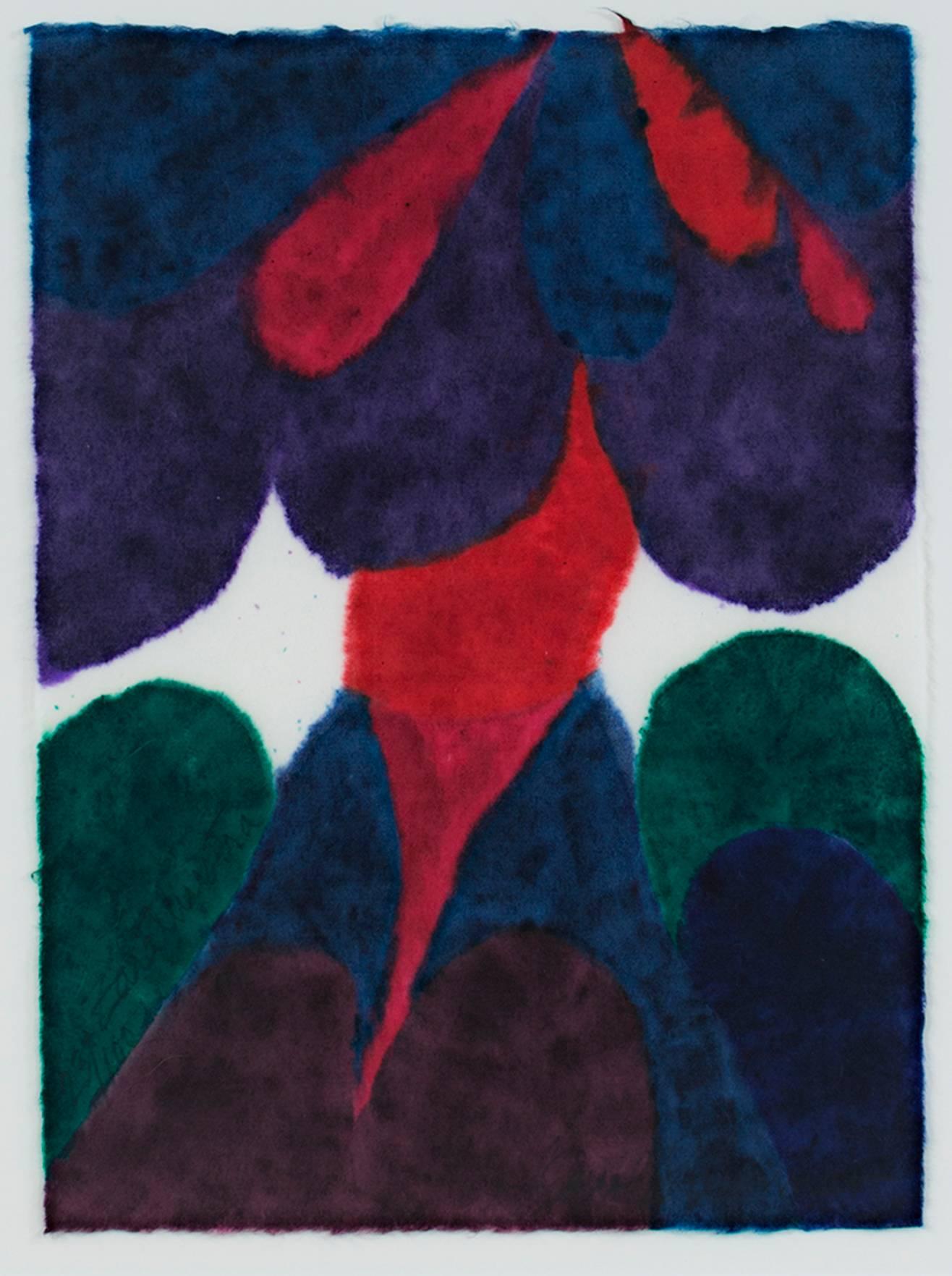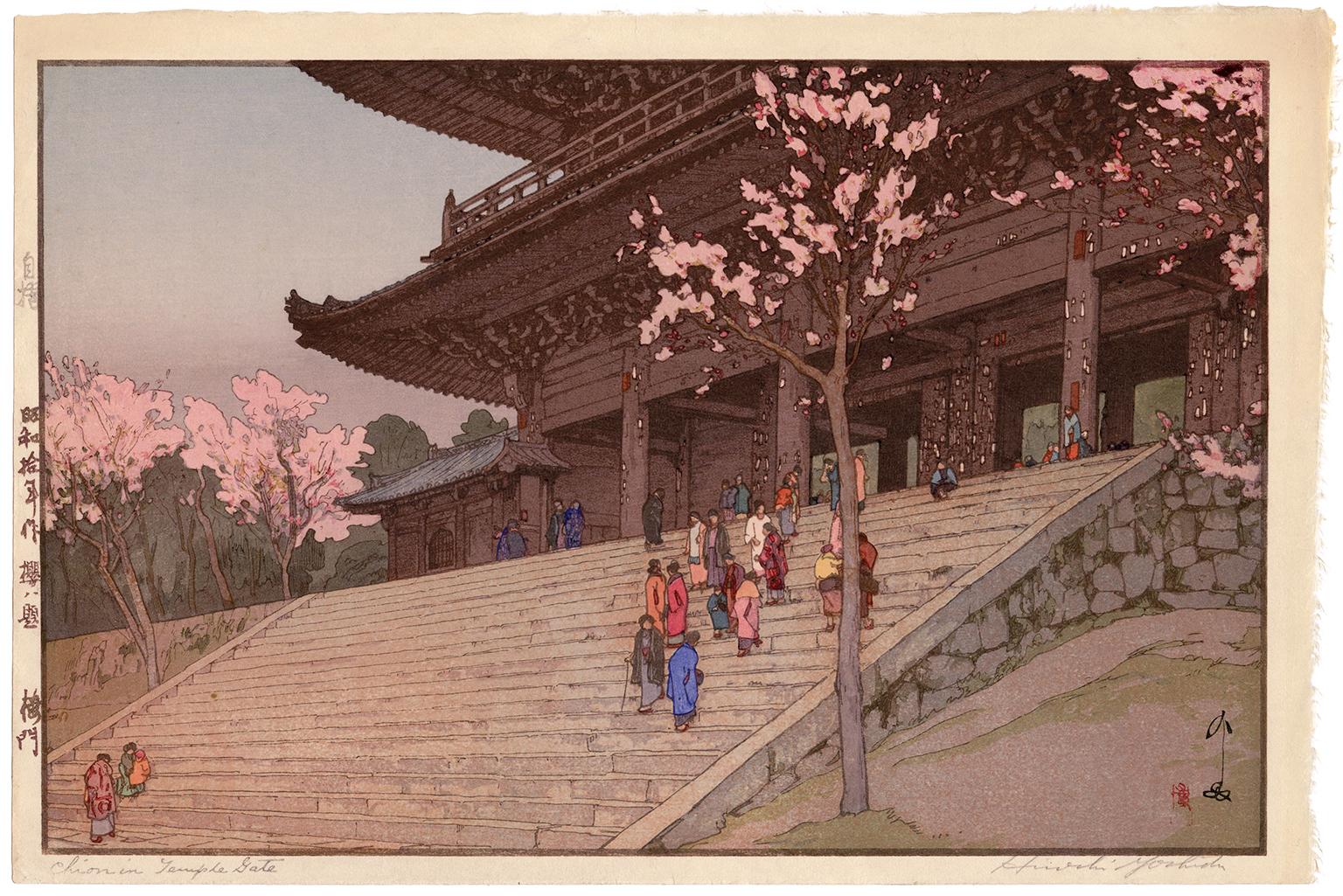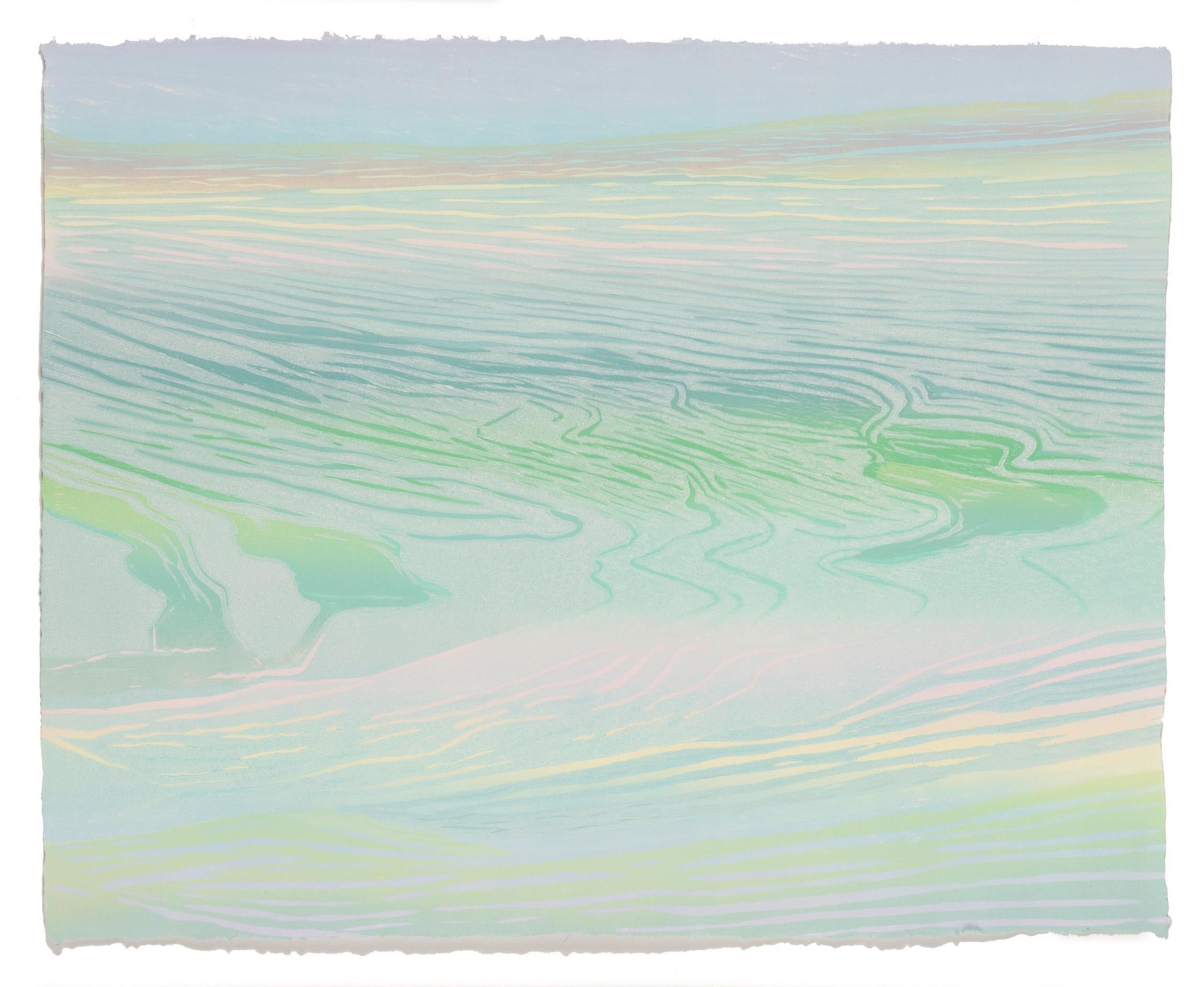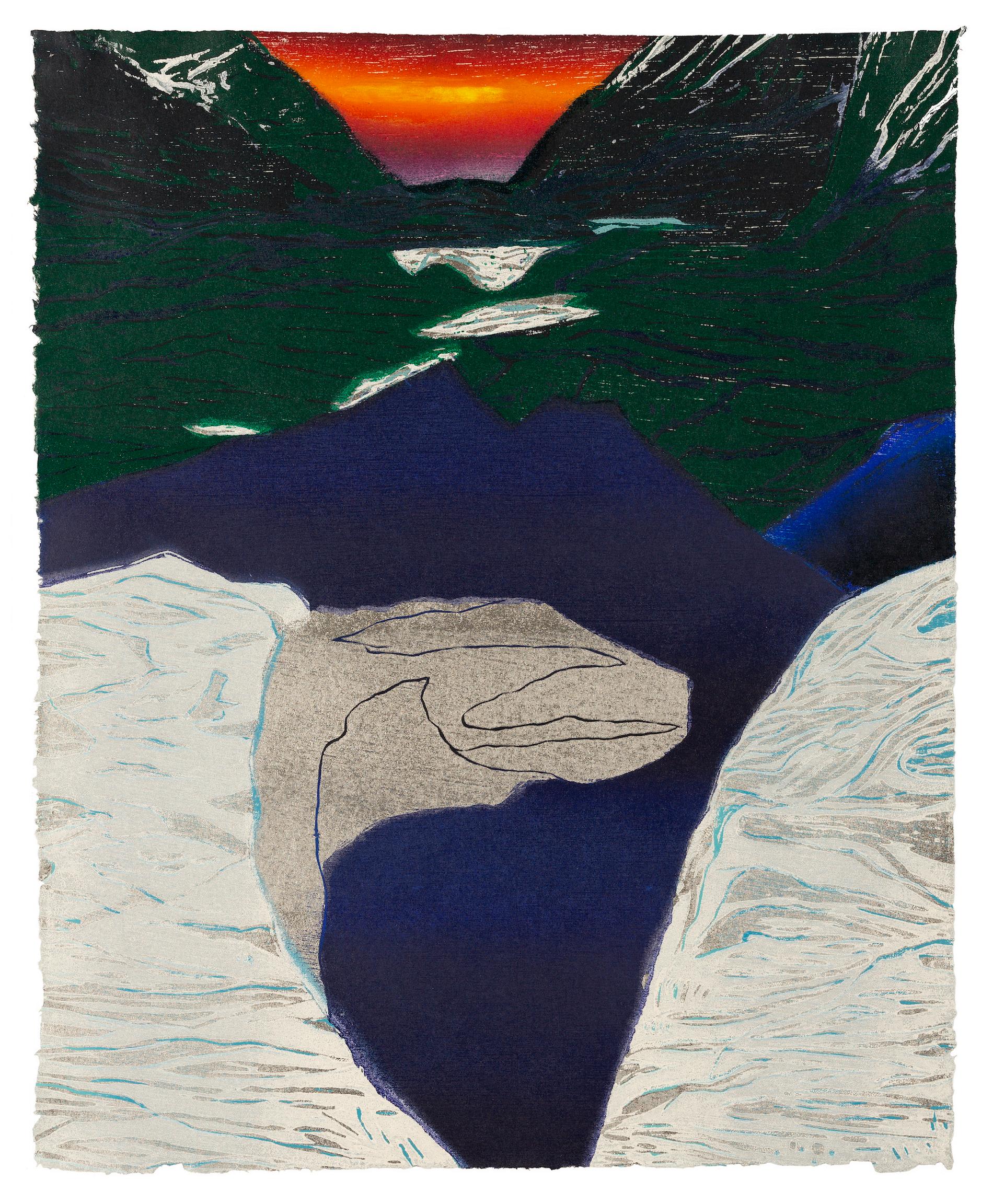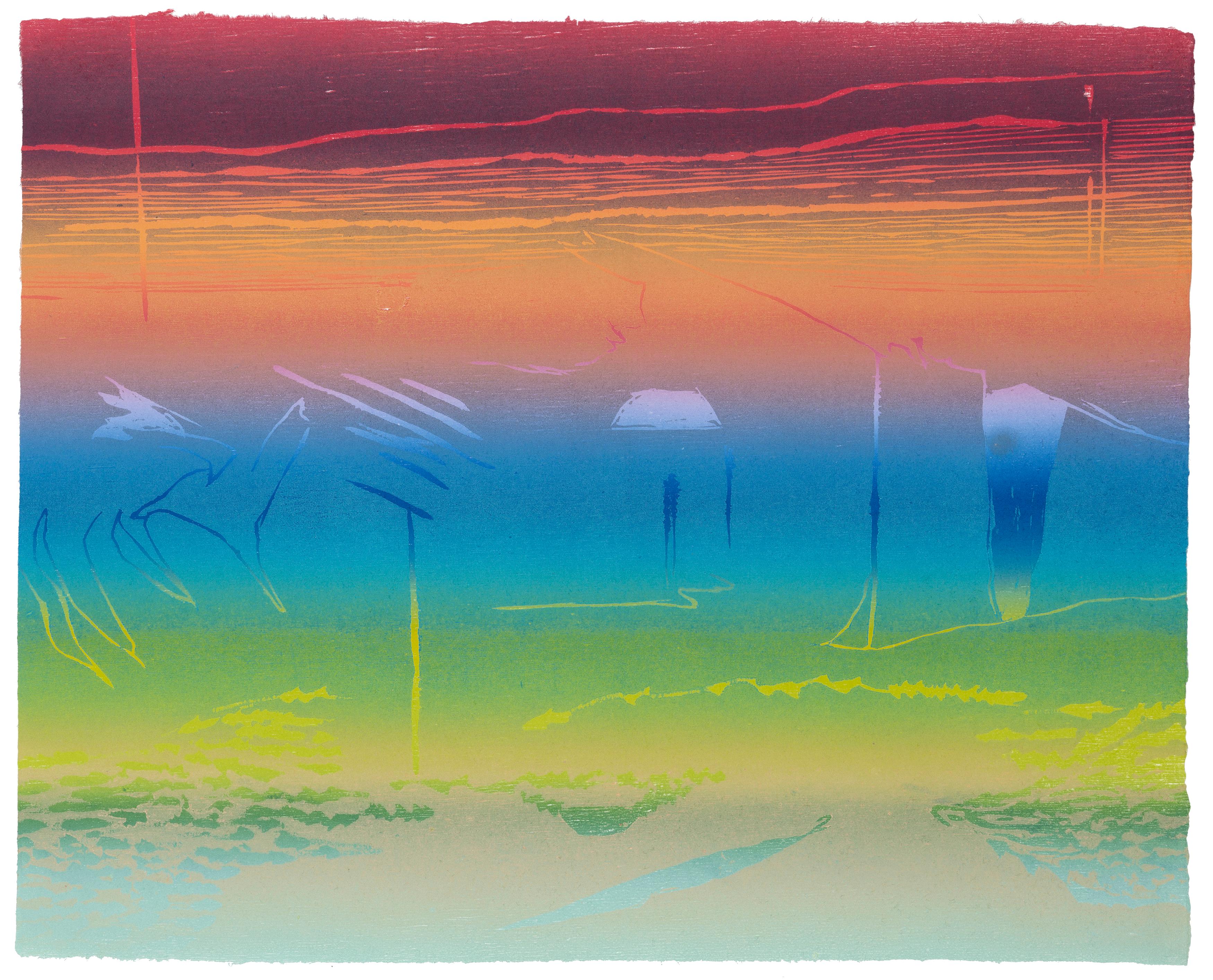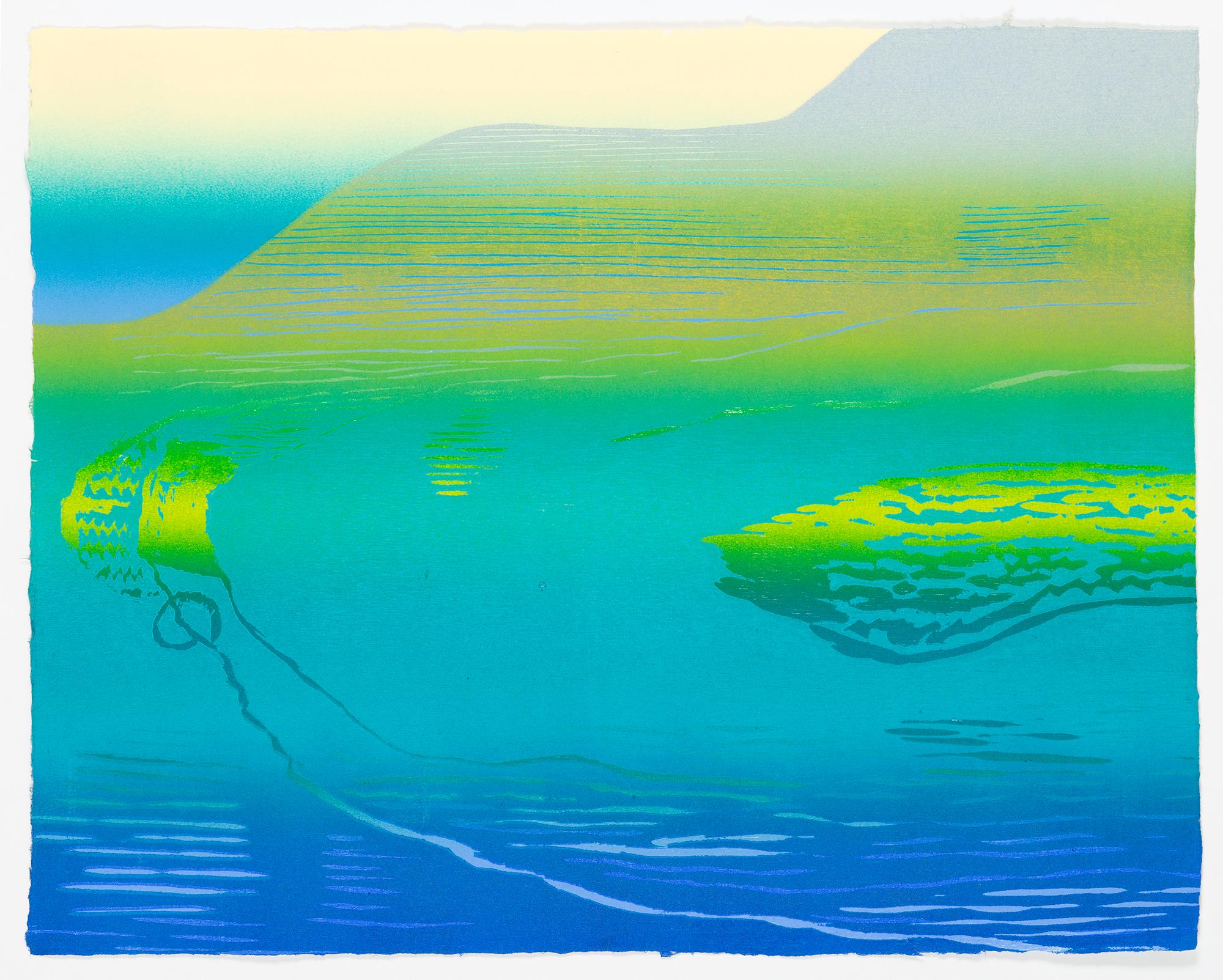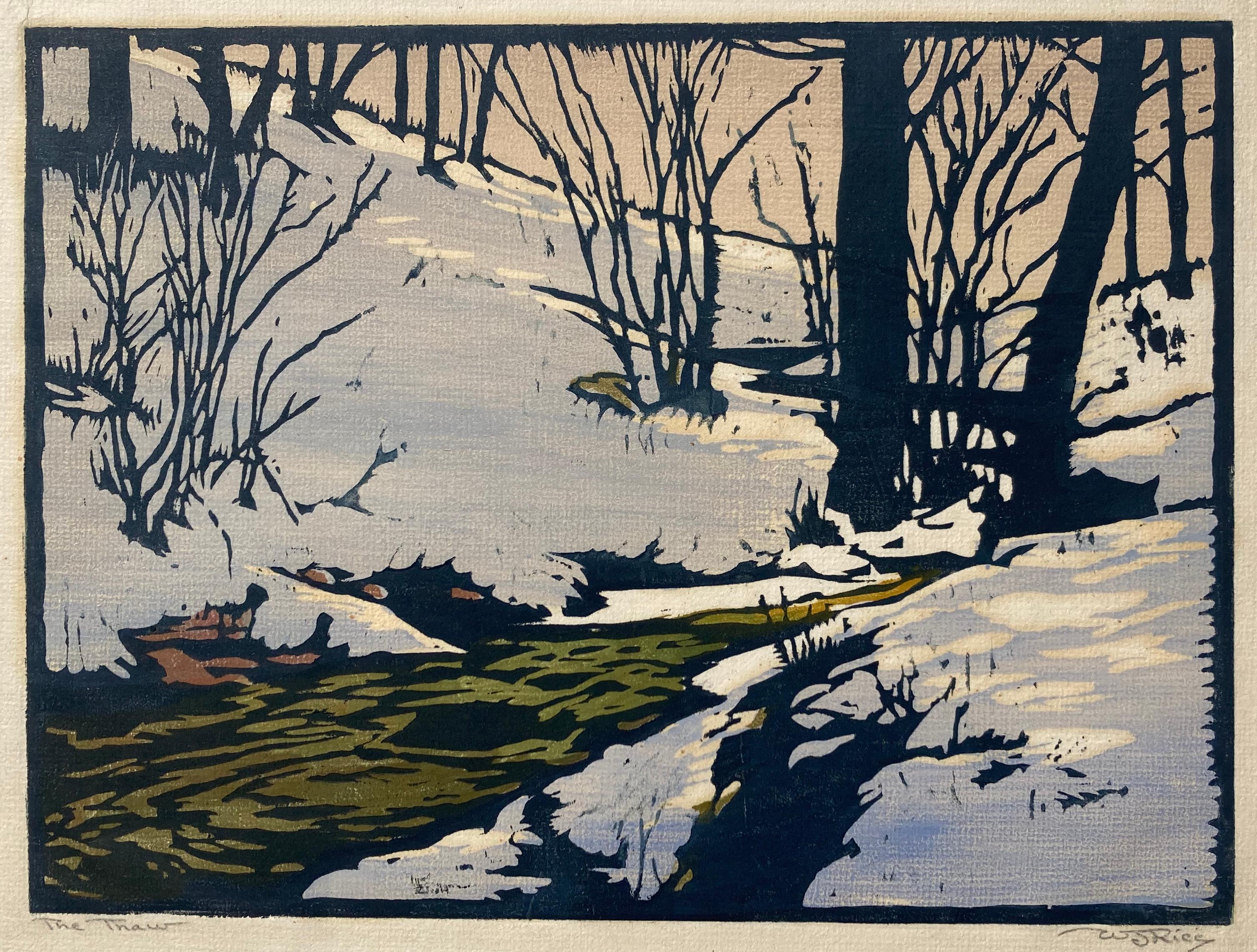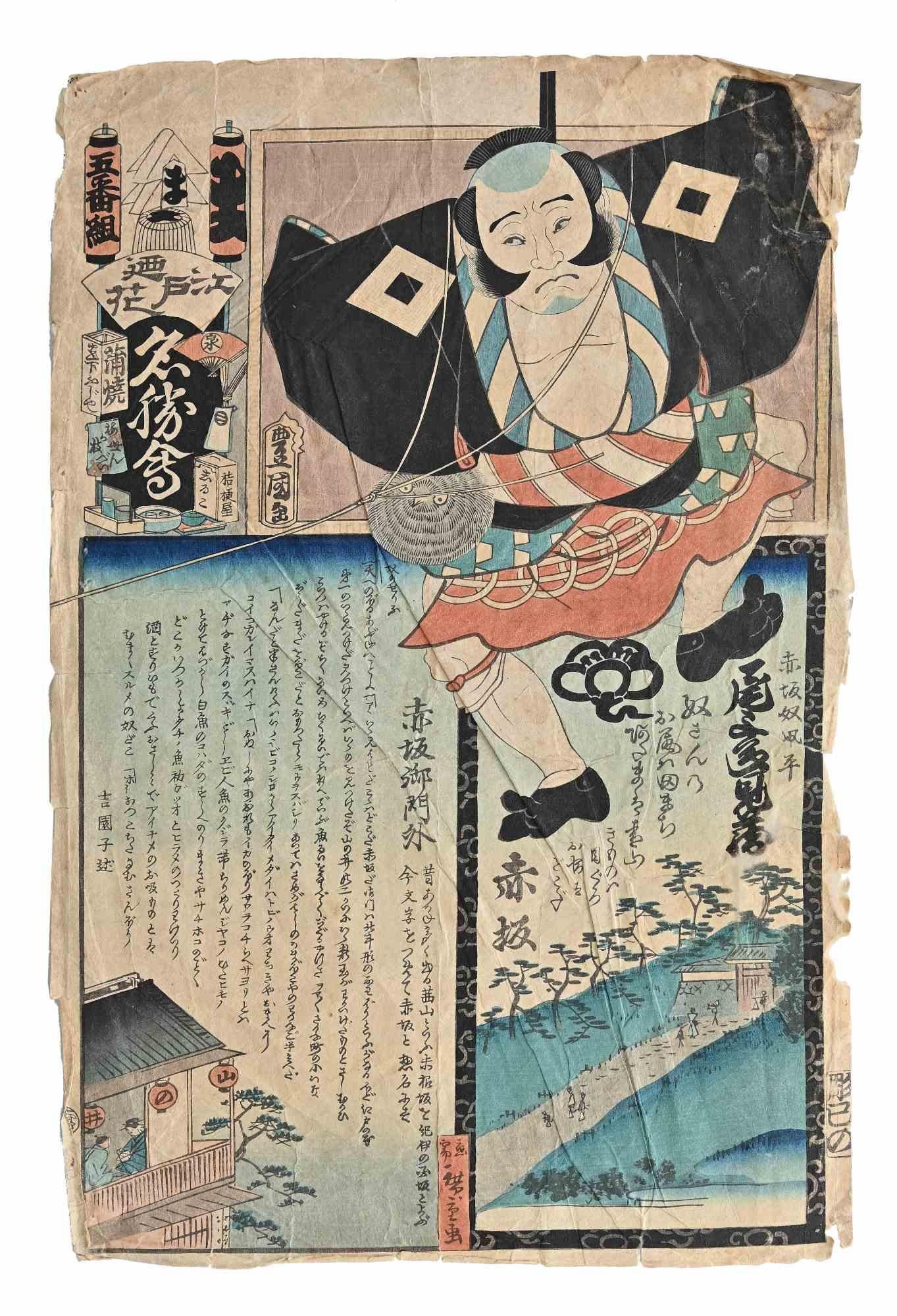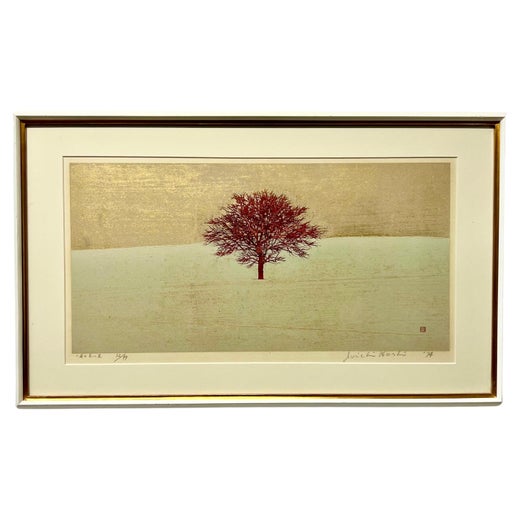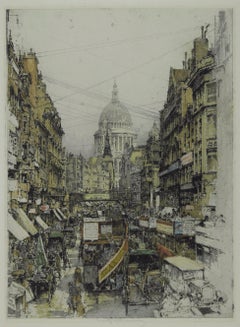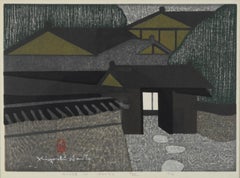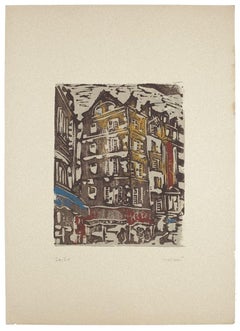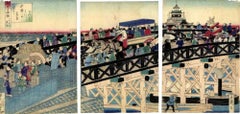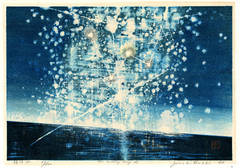
The Milky Way (A)
View Similar Items
Want more images or videos?
Request additional images or videos from the seller
1 of 2
Joichi HoshiThe Milky Way (A)1968
1968
About the Item
- Creator:Joichi Hoshi (1913 - 1979, Japanese)
- Creation Year:1968
- Medium:
- Period:
- Condition:Has some staining but does not compromise the image.
- Gallery Location:Fairlawn, OH
- Reference Number:Seller: UK21481stDibs: LU140539402
Joichi Hoshi
Joichi Hoshi was a Japanese printmaker best known for his depictions of trees in centered compositions. The trees are often shown leafless with monochromatic backgrounds, sometimes incorporating gold or silver leaf into the layers of the intricate woodblock process. Born in 1913 in Niigata, Japan, Hoshi began his artistic career after working as an elementary school teacher in Taiwan for several years. He later became a mimeograph printer and started creating his own prints. The artist graduated from the Musashino University of Fine Arts in 1956. Before focusing on his recurring motif of trees in the 1970s, Hoshi depicted galaxies and constellations. He died on June 17, 1979 in Tokyo, Japan. Today, Hoshi’s works are held in the collections of the National Museum of Modern Art in Tokyo, The Museum of Modern Art in New York, the Art Institute of Chicago, and the Cincinnati Art Museum, among others.
About the Seller
5.0
Recognized Seller
These prestigious sellers are industry leaders and represent the highest echelon for item quality and design.
Platinum Seller
These expertly vetted sellers are 1stDibs' most experienced sellers and are rated highest by our customers.
Established in 1978
1stDibs seller since 2013
719 sales on 1stDibs
Typical response time: 1 hour
Associations
International Fine Print Dealers Association
More From This SellerView All
- Daybreak over Lake YamanakaBy Kawase HasuiLocated in Fairlawn, OHDaybreak over Lake Yamanaka Color woodcut, 1931 Published by the Watanabe Color Print Co. Watanabe seal "D" (1931-1941) See photo Pre-war design and pre-war printing Lake Yamanaka i...Category
1930s Landscape Prints
MaterialsWoodcut
- Fleet Street, LondonBy Luigi KasimirLocated in Fairlawn, OHFleet Street, London Soft ground etching & aquatint, c. 1936 Signed in pencil by the artist (see photo) Condition: Very good condition with brown paper tape along the edges of the la...Category
1930s Landscape Prints
MaterialsEtching, Woodcut
- House in KyotoBy Kiyoshi SaitōLocated in Fairlawn, OHHouse in Kyoto Color woodcut, 1963 Signed in white brush bottom left of image, along with the artist's red stamp (see photo) Titled, dated and numbered in pencil bottom margin (see p...Category
1960s Contemporary Landscape Prints
MaterialsWoodcut
- Lingering Snow Mount YoshinoBy Utagawa KuniyoshiLocated in Fairlawn, OHLingering Snow Mount Yoshino (Shidzuka-gozen toiling through snow after her last farewell to Yoshitsune) Signed: Ichiyusai Kuniyoshi ga Censor seal: Tanaka Series: Kenjo hakkei ...Category
1840s Figurative Prints
MaterialsWoodcut
- BougivalBy Maurice de VlaminckLocated in Fairlawn, OHBougival Woodcut, 1914 Signed and numbered in pencil Edition 30, this numberd 22 Printed on laid Van Gelder Zonen paper Published by Henri Kanweiler, Paris Printed by Paul Birault, Paris Bougival is located west of Paris, on the left bank of the River Seine. This woodcut was inspired by Vlaminck's 1905 Fauvist masterpiece of the same title in the collection of the Detroit Institute of Art. An impression of this image is in the Yale Univeristy Art Gallery, Condition: Very slight sun staining, otherrwise very good Image/block size: 13 1/4 x 16 1/4 inches Sheet size: 19 1/8 x 22 1/8 inches Reference: Walterskirchen 11b Maurice de Vlaminck (4 April 1876 – 11 October 1958) was a French painter. Along with André Derain and Henri Matisse, he is considered one of the principal figures in the Fauve movement, a group of modern artists who from 1904 to 1908 were united in their use of intense colour.] Vlaminck was one of the Fauves at the controversial Salon d'Automne exhibition of 1905. Life Maurice de Vlaminck was born on Rue Pierre Lescot in Paris. His father Edmond Julien was Flemish and taught violin and his mother Joséphine Caroline Grillet came from Lorraine and taught piano His father taught him to play the violin.[3] He began painting in his late teens. In 1893, he studied with a painter named Henri Rigalon on the Île de Chatou In 1894 he married Suzanne Berly. The turning point in his life was a chance meeting on the train to Paris towards the end of his stint in the army. Vlaminck, then 23 and already active in anarchist circles in Paris, met an aspiring artist, André Derain, with whom he struck up a lifelong friendship.] When Vlaminck completed his army service in 1900, the two rented a studio together, the Maison Levanneur, which now houses the Cneai,[6] for a year before Derain left to do his own military service. In 1902 and 1903 he wrote several mildly pornographic novels illustrated by Derain. He painted during the day and earned his livelihood by giving violin lessons and performing with musical bands at night. Vlaminck participated in the controversial 1905 Salon d'Automne exhibition. After viewing the boldly colored canvases of Vlaminck, Henri Matisse, André Derain, Albert Marquet, Kees van Dongen, Charles Camoin, and Jean Puy, the art critic Louis Vauxcelles disparaged the painters as "fauves" (wild beasts), thus giving their movement the name by which it became known, Fauvism. In 1911, Vlaminck traveled to London and painted by the Thames. In 1913, he painted again with Derain in Marseille and Martigues. In World War I he was stationed in Paris, and began writing poetry. Eventually he settled in Rueil-la-Gadelière, a small village south-west of Paris. He married his second wife, Berthe Combes, with whom he had two daughters. From 1925 he traveled throughout France, but continued to paint primarily along the Seine, near Paris. Resentful that Fauvism had been overtaken by Cubism as an art movement Vlaminck blamed Picasso "for dragging French painting into a wretched dead end and state of confusion". During the Second World War, Vlaminck visited Germany and on his return published a tirade against Picasso and Cubism in the periodical Comoedia in June 1942. Vlaminck wrote many autobiographies. Vlaminck died in Rueil-la-Gadelière on 11 October 1958. Artistic career Two of Vlaminck's groundbreaking paintings, Sur le zinc (At the Bar) and L'homme a la pipe (Man Smoking a Pipe) were painted in 1900. For the next few years Vlaminck lived in or near Chatou (the inspiration for his painting houses at Chatou), painting and exhibiting alongside Derain, Matisse, and other Fauvist painters. At this time his exuberant paint application and vibrant use of colour displayed the influence of Vincent van Gogh. Sur le zinc called to mind the work of Toulouse-Lautrec and his portrayals of prostitutes and solitary drinkers, but does not attempt to probe the sitter's psychology—a break with the century-old European tradition of individualized portraiture. According to art critic Souren Melikian, it is "the impersonal cartoon of a type. In his landscape paintings, his approach was similar. He ignored the details, with the landscape becoming a vehicle through which he could express mood through violent colour and brushwork. An example is Sous bois, painted in 1904. The following year, he began to experiment with "deconstruction," turning the physical world into dabs and streaks of colour that convey a sense of motion. His paintings Le Pont de Chatou (The Chatou Bridge), Les Ramasseurs de pommes de terre (The Potato Pickers...Category
1910s Fauvist Landscape Prints
MaterialsWoodcut
- A l'Exposition Universelle: La Tour EiffelBy Auguste Louis LepèreLocated in Fairlawn, OHA l'Exposition Universelle: La Tour Eiffel Woodengraving, 1889 Signed and numbered in ink by the artist (see photo) Edition: Deluxe ...Category
1880s Impressionist Landscape Prints
MaterialsWoodcut
You May Also LikeView All
- "Zarathustra, " Abstract Volcano Woodcut signed by Carol SummersBy Carol SummersLocated in Milwaukee, WI"Zarathustra" is an original color woodcut by Carol Summers. The artist signed the piece in the image. This woodcut depicts an erupting volcano in simplified color fields. The editio...Category
Early 2000s Landscape Prints
MaterialsWoodcut
- Houses - Woodcut by Carlo Mazzoni - 1977By Carlo MazzoniLocated in Roma, ITHouses in the city is an original woodcut realized by Carlo Mazzoni. Hand-signed by the artist in pencil on the lower right corner. Numbered on the lower-left corner. Edition 24/60....Category
1970s Figurative Prints
MaterialsWoodcut
- Nihonbashi Bridge - Woodcut Print by Utagawa Yoshitora - 1875By Utagawa YoshitoraLocated in Roma, ITScene on the Nihonbashi Bridge is an artwork realized in 1875 by Utagawa Yoshitora. Woodcut print triptych. Signed: Mosai ga. Publisher: Sawamuraya...Category
1870s Modern Figurative Prints
MaterialsWoodcut
- 'Chion-in Temple Gate' from 'Eight Scenes of Cherry Blossoms' — Jizuri SealBy Hiroshi YoshidaLocated in Myrtle Beach, SCHiroshi Yoshida, 'Chion-in Temple Gate (Sunset)' from the series 'Eight Scenes of Cherry Blossoms (Sakura hachi dai: Sakura mon)', color woodblock print, 1935. Signed in brush 'Yoshida' and in pencil 'Hiroshi Yoshida'. A superb, early impression, with fresh colors; the full sheet with margins, on cream Japan paper; an area of slight toning in the top right sheet corner, not affecting the image, otherwise in excellent condition. Marked with a jizuri (self-printed) seal, upper left margin. Self-published by the artist. Image size 9 5/8 x 14 3/4 inches (444 x 375 mm); sheet size 10 7/8 x 16 inches (276 x 406 mm). Archivally sleeved, unmatted. Provenance: M. Nakazawa, Tokyo. Literature: Japanese Landscapes of the 20th century (Hotei Publishing calendar), 2001, May. Collections: Honolulu Museum of Art, Museum of Fine Arts, Boston. ABOUT THE IMAGE Located in Kyoto, Chionin is the main temple of the Jodo sect of Japanese Buddhism, one of the most popular Buddhist sects in Japan, having millions of followers. The Sanmon Gate, Chionin's entrance gate, standing 24 meters tall and 50 meters wide, it is the largest wooden temple gate in Japan and dates back to the early 1600s. Behind the gate, a wide set of stairs leads to the main temple grounds. ABOUT THE ARTIST Painter and printmaker Yoshida Hiroshi (1876-1950) is regarded as one of the greatest artists of the Japanese 'shin hanga' (New Print) movement. Yoshida was born as the second son of Ueda Tsukane in Kurume, Fukuoka Prefecture, a schoolteacher from an old samurai family. In 1891 he was adopted by his art teacher Yoshida Kasaburo in Fukuoka and took his surname. In 1893 he went to Kyoto to study painting, and the following year to Tokyo to join Koyama Shotaro's Fudosha private school; he also became a member of the Meiji Fine Arts Society. These institutions taught and advocated Western-style painting, greatly influencing Yoshida’s artistic development. In 1899 Yoshida had his first American exhibition at Detroit Museum of Art (now Detroit Institute of Art), making the first of many visits to the US and Europe. In 1902 he helped reorganize the Meiji Fine Arts Society, renaming it the Taiheiyo-Gakai (Pacific Painting...Category
1930s Showa Figurative Prints
MaterialsWoodcut
- Summer SoleilLocated in Bloomington, IL"Summer Soleil" is a woodcut print by Cathie Crawford, an abstracted view of a shimmering water surface. The artist carved the blocks and printed the e...Category
21st Century and Contemporary Contemporary Abstract Prints
MaterialsWoodcut
- Once Upon A Glacier...Located in Bloomington, IL"Once Upon A Glacier" is a limited edition woodcut by Cathie Crawford. The woodblocks were cut and printed by the artist on Hosho Professional paper in...Category
21st Century and Contemporary Contemporary Landscape Prints
MaterialsWoodcut
Recently Viewed
View AllMore Ways To Browse
Joseph Mckenzie
Juvenal Sanso
Kubo Shunman
Liberty Bonds Ww1
Lichtenstein Sunrise
Lilian Miller
Louis Orr Duke Chapel Etching
Luigi Kasimir Fleet Street
Marco Sadeler
Mark King Serigraph
Martin Lewis White Monday
Maurice de Vlaminck On Sale
Maurice Utrillo On Sale
Nell Revel Smith
Nell Revel
Orfeo Tamburi On Sale
Paolo Boni
Patrick Hughes Golden
